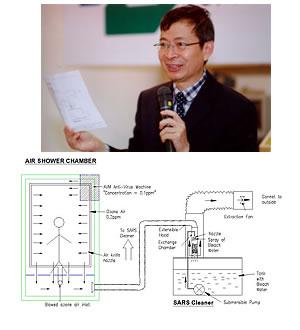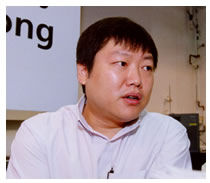Showering in ozone to deter viruses
Shirley Lam
Medical staff wears protective face masks and gowns when working in wards for highly infectious diseases such as SARS. But how can a virus be prevented from transferring from the cloth
ing into the public? And how can we ensure that medical staff will not contract a virus as the clothing is removed? An "air shower" facility currently under development by the Department of Building and Construction (BC) may provide a solution.Ozone kills viruses by oxidization. "Using ozone to kill viruses is no novelty," said Professor Andrew Leung, Head of BC. "It is
not recommended or commonly used because a high level of ozone concentration is harmful to human beings, and in the past there was no effective way to maintain a safe level of concentration." Now, however, Dr Ng explained, "With an ozone emitter developed by CityU and RNI (HK) Ltd, we can keep the concentration of ozone at a safe level, which is between 0.05 and 0.1 ppm, as defined by the US Occupational Safety and Health Administration (OSHA)." According to OSHA, it is safe to work in an office with a level of ozone up to 0.1 ppm for a maximum of eight hours per day for six days. This ozone emitter, installed within the "anti-virus machine," will ensure a constant concentration of ozone at 0.1 ppm in the "air shower" facility.In addition to killing viruses with ozone, the "air shower" facility is connected to a "SARS Cleaner," which BC previously developed to prevent cross infection in hospital intensive care units. The "SARS Cleaner" received HK$0.56m from the special grant for SARS research offered by the Research Grants Council (RGC) in June and is the only non-medical SARS research project. It is now incorporated with the "air shower" facility to ensure that the air is purified further before being released from the room. Professor Leung and his research team believe that the facility can also be designed as a corridor through which patients' visitors also would be cleansed before departing from the hospital.
"The use of ozone to kill viruses is more environmentally friendly than using bleach," said Mr Joseph Wong, BC Laboratory Manager. "Unlike the gallons and gallons of bleach that eventually pour into the sea and pollute the water, ozone reverts to oxygen in 20 minutes and does not generate any pollutants."BC is now seeking external funding to set up a prototype of the facility to conduct further testing. Plans are also underway to expand its application to the ventilation systems of shopping malls and lifts.


